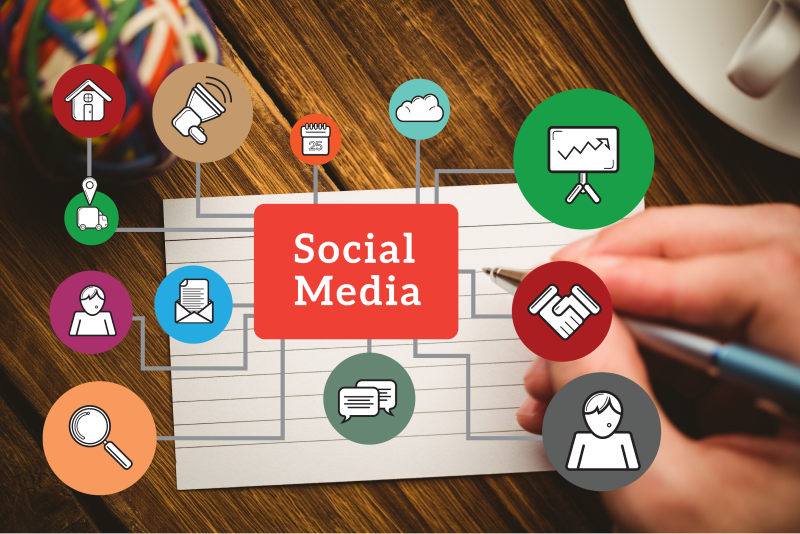
What Is Social Listening And Its Importance To Your Brand
Do you want to keep your ear close to the ground to refine your marketing strategies? With the right social listening tactics, you can monitor these conversations in real-time.
In this article, you will learn practical strategies to interpret customer sentiments to boost your brand reputation, drive engagement, and ultimately boost your bottom line. Let’s get started.
What Is Social Listening?
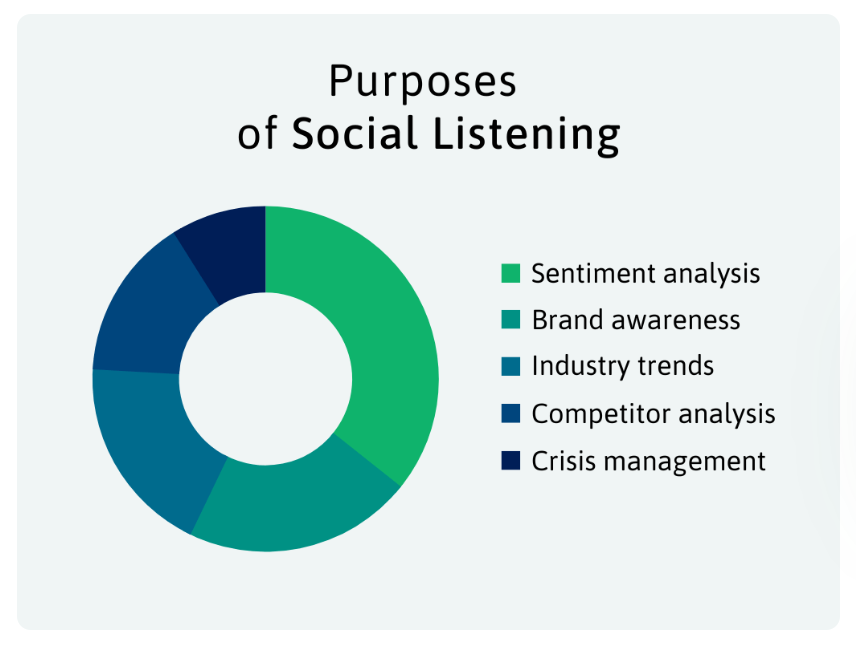
Social listening is monitoring social media channels, forums, blogs, and other online platforms to understand what people say about your brand, industry, or relevant topics.
It involves tracking social media conversations and keywords to learn about customer opinions, trends, and sentiments. Here is a great example from Green Supply. If you make an Instagram search with their branded hashtag #GreenSupply, you can track what people are discussing about the brand online.
For example comments like “Oh I like that mask!!!” and “Also your glasses” show positive interest in the brand’s products.
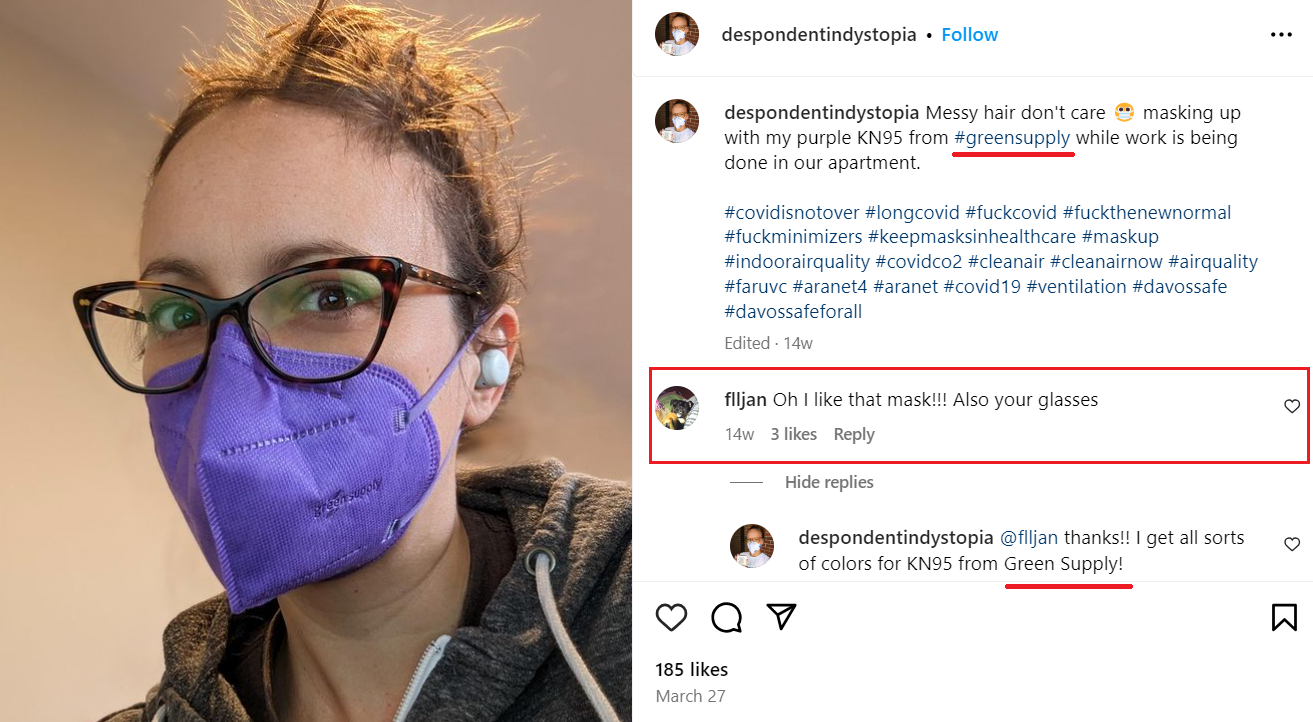
Social listening gives you the answers to questions like:
- Who are my influencers and advocates?
- What are customers feeling about my brand?
- What content resonates most with my audience?
- What are their common pain points or complaints?
- What topics or trends are emerging in my industry?
- How are competitors perceived compared to my brand?
The Power Of Social Listening: 6 Ways It Shapes Your Brand
61% of businesses use social listening, and 82% of marketers see it as crucial for planning. Go through the 6 ways, and pick out the strategies that best align with your needs.
1. Improves How People Think Of Your Brand
Social listening helps you understand what customers are saying online. Pay attention to these online conversations to quickly respond to questions and concerns. For example, if you find common questions coming up, create an FAQ to answer them all in one place.
You can also highlight what customers love about your brand and use that in your marketing to build trust.
Moreover, proactively manage online reviews and address negative feedback publicly. For example:
- Engage with positive reviews to thank customers and reinforce positive experiences.
- Address negative feedback publicly to show how transparent and committed you are to resolving issues.
- Acknowledge concerns, apologize for shortcomings, and offer solutions or assurances openly.
- Encourage customers with issues to contact you directly for a personalized resolution.
If you’re stretched for time and need expert-level support in managing your social media presence, hire a social media manager to help you handle customer reviews, engagement, and your online reputation management. Alternatively, you can hire business interns to support your social media strategies at a more affordable cost.
2. Assists In Competitor Analysis
Social listening lets you monitor competitors’ activities, understand their strategies, and identify opportunities or gaps in the market. This competitive intelligence helps you differentiate your brand and capitalize on emerging trends. You can get information about:
- How do competitors manage crises or negative publicity?
- Who are the influencers or partners collaborating with competitors?
- How engaged are customers on competitors’ social media channels?
- What are customers saying in their reviews, comments, and complaints?
- What type of content do competitors publish, and how well does it perform?
For example, you can monitor forums and review sites for customer complaints about competitors’ products. Identify pain points and highlight your brand’s strengths in those areas through targeted ads and content that emphasize your superior features.
3. Identifying Influencers & Advocates
Social listening helps you identify influencers and brand advocates who positively influence your brand’s reputation. Engage with these influencers to boost reach and credibility within your target audience.
Once you’ve identified potential influencers, follow these strategies to help build a positive brand presence:
- Engage with influencers by sharing their content, commenting on their social media posts, and reaching out for collaborations.
- Partner with influencers to promote your brand, products, or services to their loyal followers.
- Learn from influencers about market trends, customer preferences, and effective content strategies.
- Use testimonials and endorsements from advocates to build trust with potential customers.
- Provide influencers with exclusive access to new products or services in exchange for reviews or endorsements.
- Support events where influencers are present or sponsor their activities to increase how visible you are online.
4. Helps In Market Research & Insights
It provides valuable insights into consumer behavior, preferences, and trends. You can use this social data to make strategic decisions about product improvements and targeted marketing.
For example, use social listening to identify demographics interested in sustainable products. Then, tailor your offerings to appeal to environmentally-conscious consumers and gain a competitive edge.
Similarly, if you’re an eCommerce seller, use social listening data on consumer trends to develop new products or optimize existing Amazon product listings for market demand.
Here are 4 ways to use social listening for industry insights:
- Monitor disruptions like new technologies, emerging competitors, or changes in legislation impacting your industry.
- Track political and social issues to understand how they can affect your brand.
- Identify gaps in the industry that could be addressed by new products, solutions, or workflows.
- Find frequently asked questions to create content that addresses your audience’s needs effectively.
5. Gives Real-Time Feedback Loop
Social listening creates a direct line of communication with your audience. Categorize feedback based on themes like product issues, customer service experiences, or marketing campaigns. For example:
- Identify recurring complaints or suggestions about the product features, quality, or usability.
- Monitor feedback to track how responsive and helpful your customer support is.
- Track sentiment and engagement levels related to specific campaigns, assessing their effectiveness and audience reception.
After categorizing feedback from social listening, take action: For product issues, fix what’s wrong promptly. For customer service, train and support your team to resolve issues faster and improve satisfaction.
A great example of this is how Amazon monitors negative feedback and takes action within an hour. When a customer complains about a data protection issue with their Amazon account, the brand responded the same day and helped the customer with the right resources.
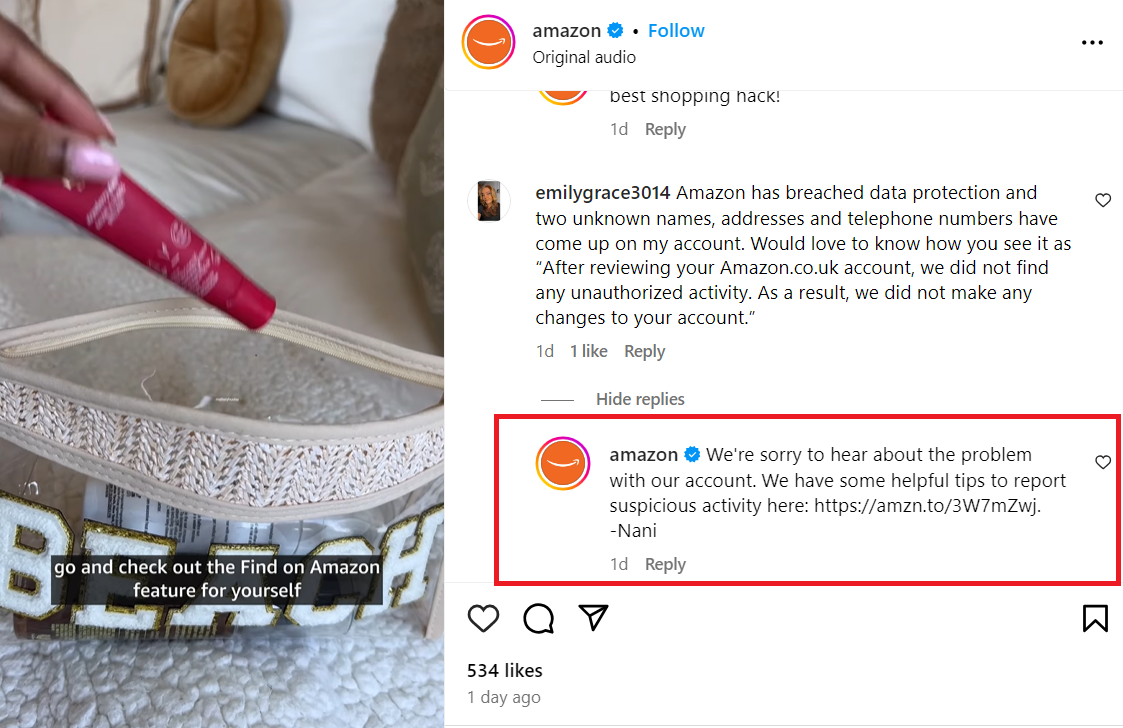
6. Helps Measuring Marketing Campaign Effectiveness
When you track mentions, sentiment, and engagement, you’re getting real-time feedback on what’s working and what isn’t. This helps you adjust your strategies quickly to maximize impact and improve return on investment.
Here are 10 engagement metrics to track which will help you optimize campaigns in real-time:
- Likes
- Reach
- Shares
- Mentions
- Comments
- Impressions
- Conversion rate
- Click-through rate (CTR)
- Sentiment analysis (positive/negative feedback)
- Engagement rate (likes + shares + comments divided by reach)
After tracking these metrics, the next step is to analyze the data to measure your campaigns’ success. Look for trends, patterns, and correlations between metrics and campaign goals. Find out which types of content or campaigns generate the most interaction and adjust strategies accordingly.
For instance, if posts with video content receive more likes and shares, create similar content in future campaigns. Adjust strategies based on the insights gained to optimize future campaigns and improve ROI.
How To Build A Social Media Listening Strategy: 7 Easy Steps
Learn how to choose the best tools, monitor conversations, track trends, and strengthen your brand’s online presence in these 7 practical steps:
I. Set Specific Social Listening Business Goals & KPIs
Define clear goals. It could be understanding customer sentiment, monitoring brand reputation, or identifying market trends. Here are 10 more goals, find what resonates best with your needs:
- Understanding competitors and industry trends to stand out.
- Handling PR crises and addressing negative feedback promptly.
- Getting content ideas from what your audience cares about.
- Finding new markets interested in your products.
- Improving customer service by solving common issues.
- Developing products based on customer feedback.
- Monitoring brand perception and sentiment.
- Tracking influencers to boost brand visibility.
- Researching customer preferences and behaviors.
- Building relationships with brand advocates for loyalty.
Once you have clear goals, set Key Performance Indicators (KPIs) to track your progress. For example, track the percentage increase in positive sentiment mentions within the next quarter. These 5 are the most important KPIs you should track:
- Sentiment Analysis: Measure positive, neutral, and negative mentions to understand overall brand sentiment. Use tools like Brandwatch, Sprout Social, or Hootsuite Insights.
- Share of Voice: Track how much your brand is talked about compared to competitors in your industry. Use Sprout Social, Hootsuite Analytics, or Mention to track mentions of your brand and competitors.
- Engagement Metrics: Monitor likes, shares, comments, and interactions to gauge audience engagement with your content. Use Facebook Insights, Twitter Analytics, and Instagram Insights.
- Response Rate and Time: Evaluate how quickly and effectively your brand responds to customer inquiries and feedback. Use Zendesk or Freshdesk compare them here to track customer inquiries and feedback across social media platforms.
- Influencer Impact: Assess the reach, engagement, and sentiment of influencer partnerships to see their effect on brand visibility and reputation. Use Traackr, BuzzSumo, or Upfluence to measure the influencer’s content reach, engagement metrics, and sentiment.
II. Choose Your Social Listening Tool
Social listening tools gather data from social media channels to analyze customer perceptions of your brand. They can monitor:
- Industry trends and discussions.
- Crisis detection and management.
- Influencer impact on brand visibility.
- Customer feedback and sentiments.
- Competitor mentions and benchmarks.
- Customer demographics and behaviors.
- Engagement metrics like likes, shares, comments.
- Brand mentions and keywords across social platforms.
Check out their starting prices and features to see which one can help you better connect with your audience and refine your marketing strategies.
| Social Media Listening Tools | Key Features | Price | Best for |
|---|---|---|---|
| Hootsuite | Multi-platform social media monitoring, keyword tracking, sentiment analysis. |
Starts at $19/month | Small to large businesses |
| Sprout Social | Social CRM tools, sentiment analysis, competitive analysis. |
Starts at $99/user/month |
Mid-sized to large enterprises |
| Brandwatch</> | AI-powered analytics, sentiment analysis, influencer identification. |
Pricing available upon request |
Large Enterprises |
III. Select Keywords You Want To Know About
Choose specific terms, phrases, or hashtags about your brand, industry, products, or services. These keywords help social listening tools monitor conversations across social media platforms. For example, if you’re a tech company, monitor terms like “tech news,” “product reviews,” and your brand name variations.
Here’s a concise list of relevant keywords and phrases for social listening:
- Your brand names
- Your brand slogans
- Your product names
- Your industry events
- Your competitor’s names
- Your campaign hashtags
- Terms related to your industry or niche
- Influencer names relevant to your brand
- Popular topics or trends among your target audience
IV. Choose Social Media Platforms Where Your Audience Hangs Out
Identify social media platforms where your target audience is most active. Use Twitter to monitor real-time updates and customer interactions or Instagram for customer engagement. Similarly, use LinkedIn to monitor industry discussions.
- Focus on Relevant Channels: Select platforms that align with your brand’s industry and audience demographics. For example, if your audience is active on TikTok, start selling on TikTok.
- Include Blogs & Forums: Blogs and forums offer valuable discussions and niche insights. Look for relevant forums where enthusiasts and experts gather to discuss topics of interest. Blogs give detailed analyses and opinions, offering nuanced perspectives.
- Monitor News Sites: Stay updated with industry news and trends by monitoring reputable news sites.
V. Customize Filters & Alerts To Fine-Tune What You Track
Customize filters and alerts in your social listening strategy to get precise insights. These 6 steps will help you optimize filters and alerts:
- Specify languages relevant to your audience to focus on meaningful social conversations.
- Narrow monitoring to specific regions to understand local trends and customer sentiments.
- Filter mentions by sentiment (positive, negative, neutral) to prioritize responses effectively.
- Set alerts for competitor mentions to gain insights into their strategies and market positioning.
- Configure alerts for trending topics to engage in timely discussions and showcase thought leadership.
- Adjust alert settings to receive real-time notifications or scheduled summaries based on urgency and analysis needs.
VI. Join The Conversation: Respond & Engage
Respond to customer inquiries, feedback, or complaints within 24 hours. Respond positively to mentions to strengthen brand loyalty. Use these 7 strategies to effectively engage with your online audience.
| Strategies To Engage & Respond | Description |
|---|---|
| Timely Interaction | Respond to customer inquiries & feedback at least within 24 hours |
| Personalized Communication | Tailor responses to individual comments or messages for a more personal touch. |
| Crisis Management | Detect & address potential crises or negativefeedback as soon as they occur. |
| Acknowledgement & Gratitude | Send personalized thank-you messages, greetings & public shout-outs on positive feedback. |
| Educational Content | Share informative content or resources in responses to educate & engage. |
| Community Engagement | Participate in relevant conversations to build a supportive online community. |
| Feedback Loop | Use interactions to gather valuable feedback that informs business decisions. |
For example, Starbucks maintains a friendly and upbeat tone in its responses on social media. They might say “Thanks for stopping by!” to acknowledge a customer visit or “We’re happy you’ve found a new summer fave!” to express gratitude and enthusiasm.
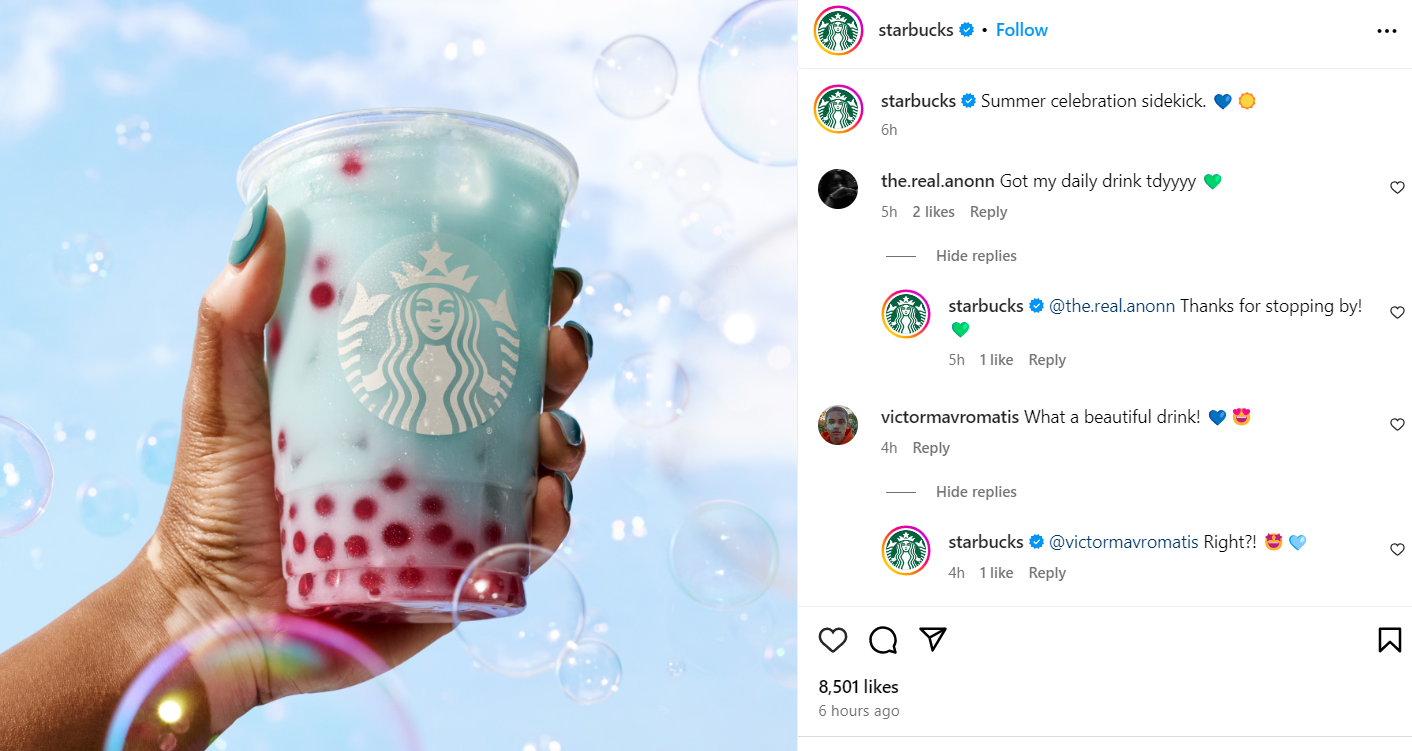
VII. Review & Adjust Based On Feedback
Once you’ve gathered the data, identify recurring themes in customer feedback and sentiment analysis. For instance, if you notice consistent complaints about a product feature, address it genuinely and release a software update to fix the issue.
The key is to leverage customer feedback into your marketing campaigns to:
- Refine your content strategy
- Adjust campaign messaging
- Improve customer service responses
Make sure to adjust your monitoring settings based on emerging trends or changes in audience behavior. For example, if there’s a growing interest in sustainable products, update your filters to include relevant keywords like “eco-friendly” or “sustainability.” This ensures your social media listening strategy remains effective and responsive.
What’s The Difference Between Social Listening & Social Monitoring?

Social listening involves analyzing online conversations to understand peoples’ sentiments, while social monitoring focuses on tracking metrics like engagement and mentions without deep analysis.
Social listening gives you information about customer preferences, trends, and sentiment so you can adjust your marketing strategies accordingly. Social monitoring, on the other hand, tells you about customer inquiries, feedback, or issues as they arise on social media platforms. So, it helps you manage customer service effectively and maintains a positive brand image online.
| Social Listening | Social Monitoring | |
|---|---|---|
| Key Focus | Analyzes broader trends and consumer sentiment. |
Responds to specific mentions or incidents promptly. |
| Key Purpose | TStrategic: Informing marketing strategies,brand perception, and market insights. |
Tactical: Managing customer service, crisis response, and direct engagement. |
| Insight vs Action | Provides insights into consumer behavior and market trends. |
Takes immediate action by responding to customer inquiries, feedback, or complaints. |
Conclusion
As you navigate these strategies, ask yourself: How promptly am I addressing customer feedback and concerns? Reflect on how to monitor industry conversations to create campaigns that resonate deeply with your audience.
If you are looking for resources to understand customer sentiments better or create effective marketing campaigns, visit our blog. Learn expert insights on digital marketing, graphic design, and web development trends to stay ahead of industry shifts and refine your online presence.
Author Bio:
Colton Garrett is a dedicated freelance writer with over nine years of experience specializing in B2B and SaaS content. You may recognize his name from platforms like Hubspot, Outbrain, Flippa, and many more.
- Author picture: here